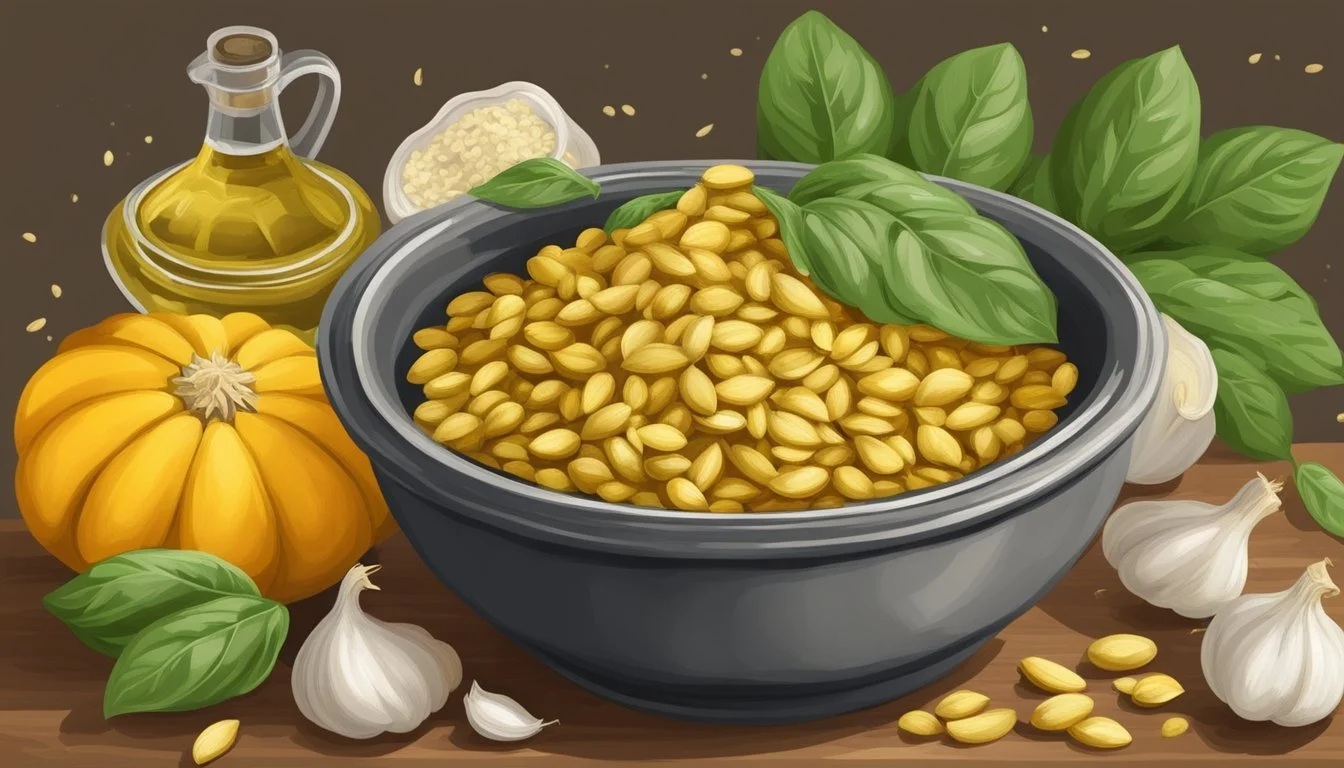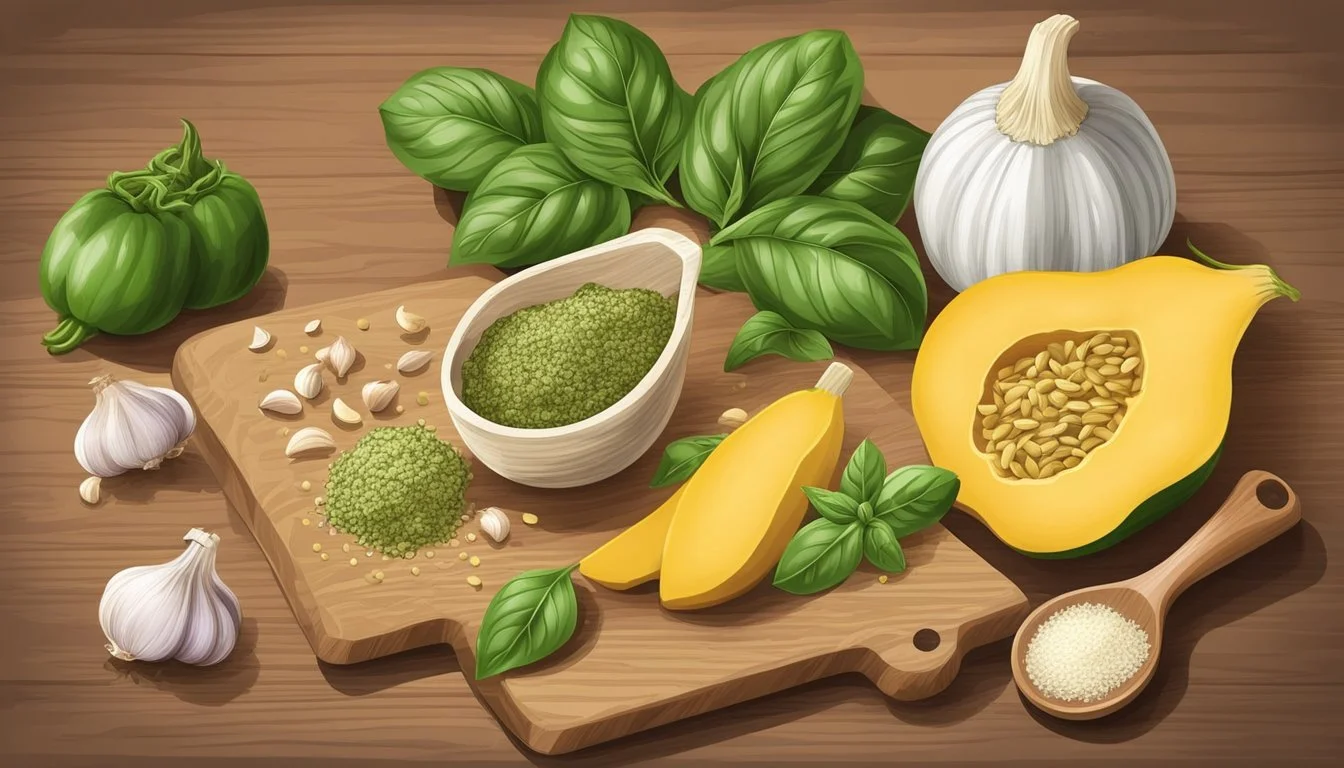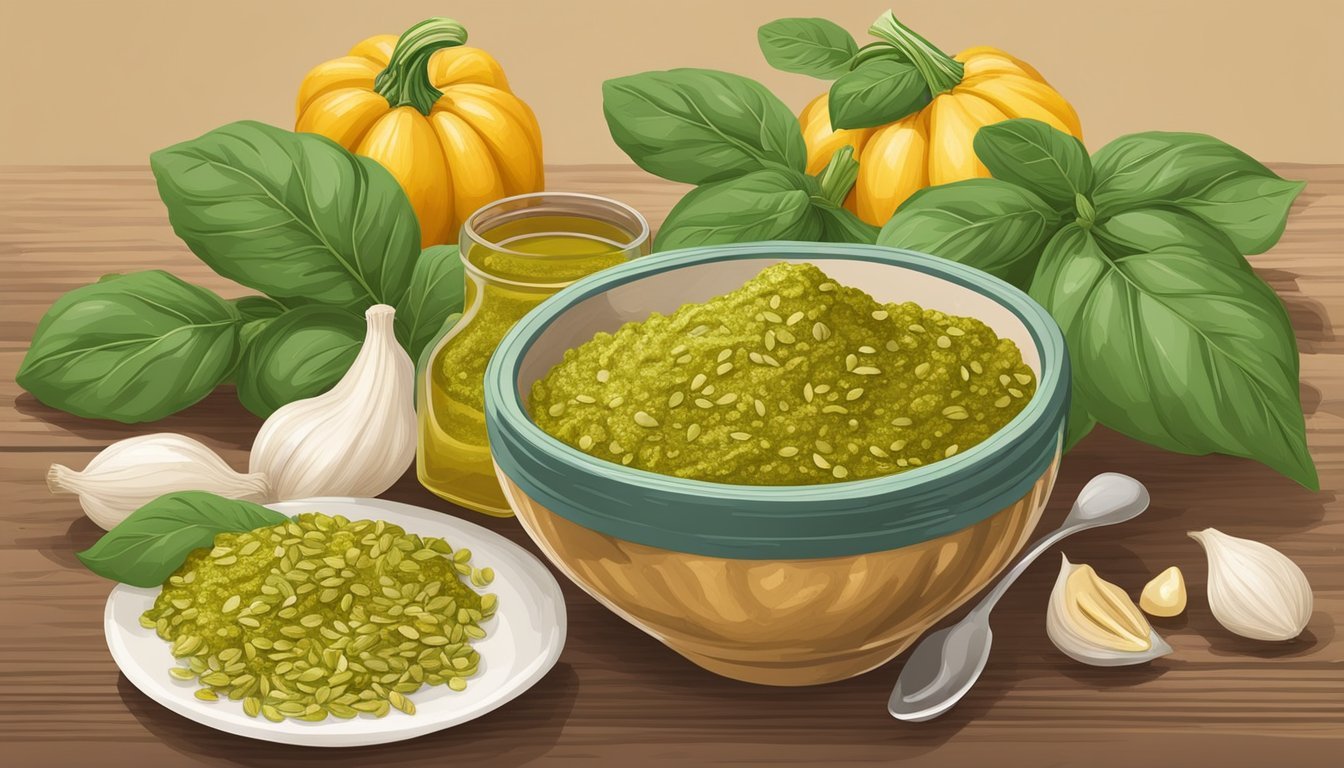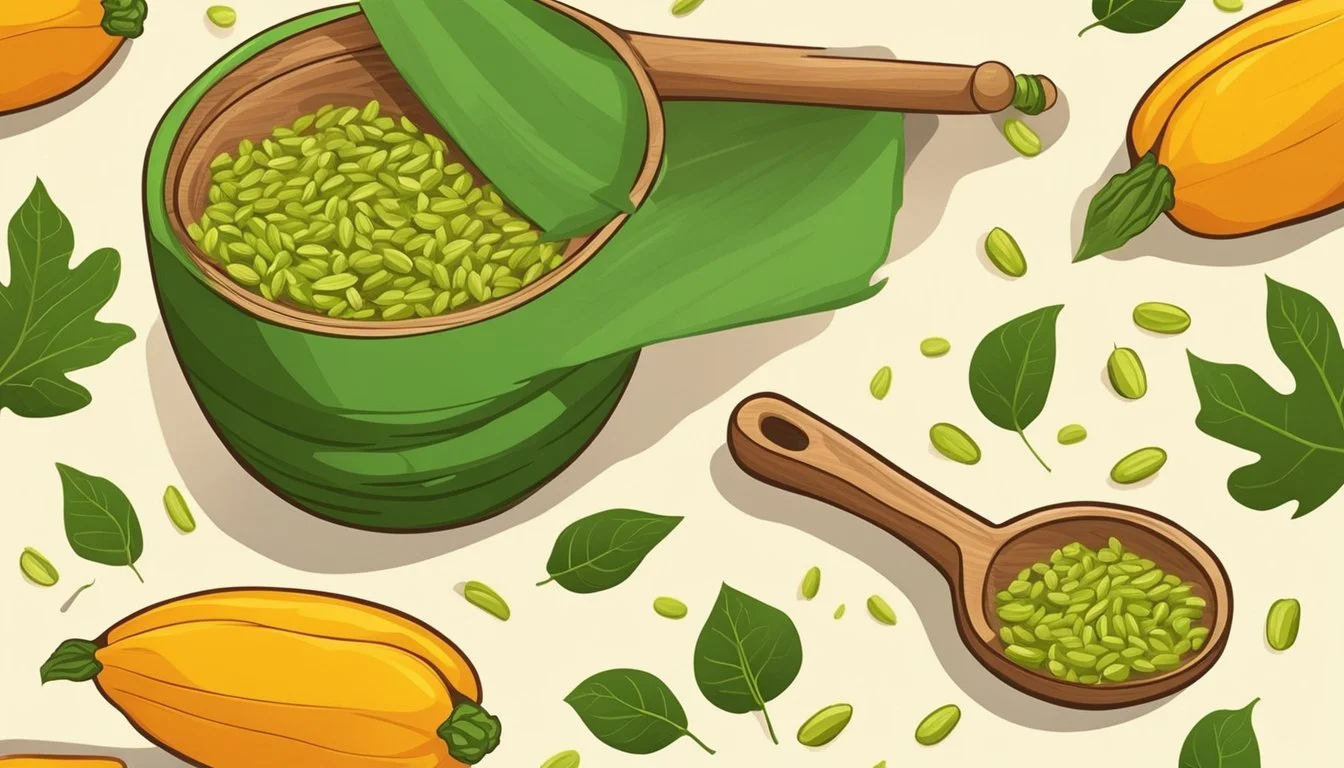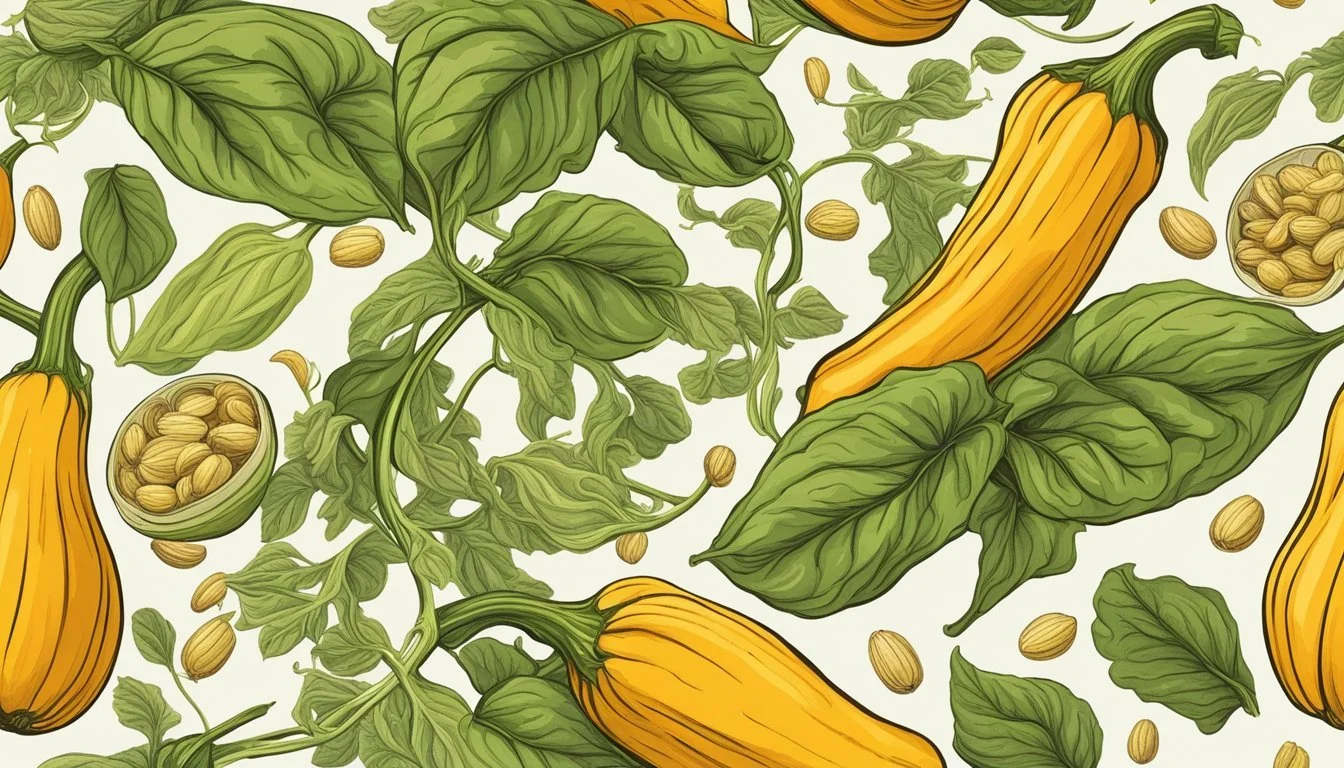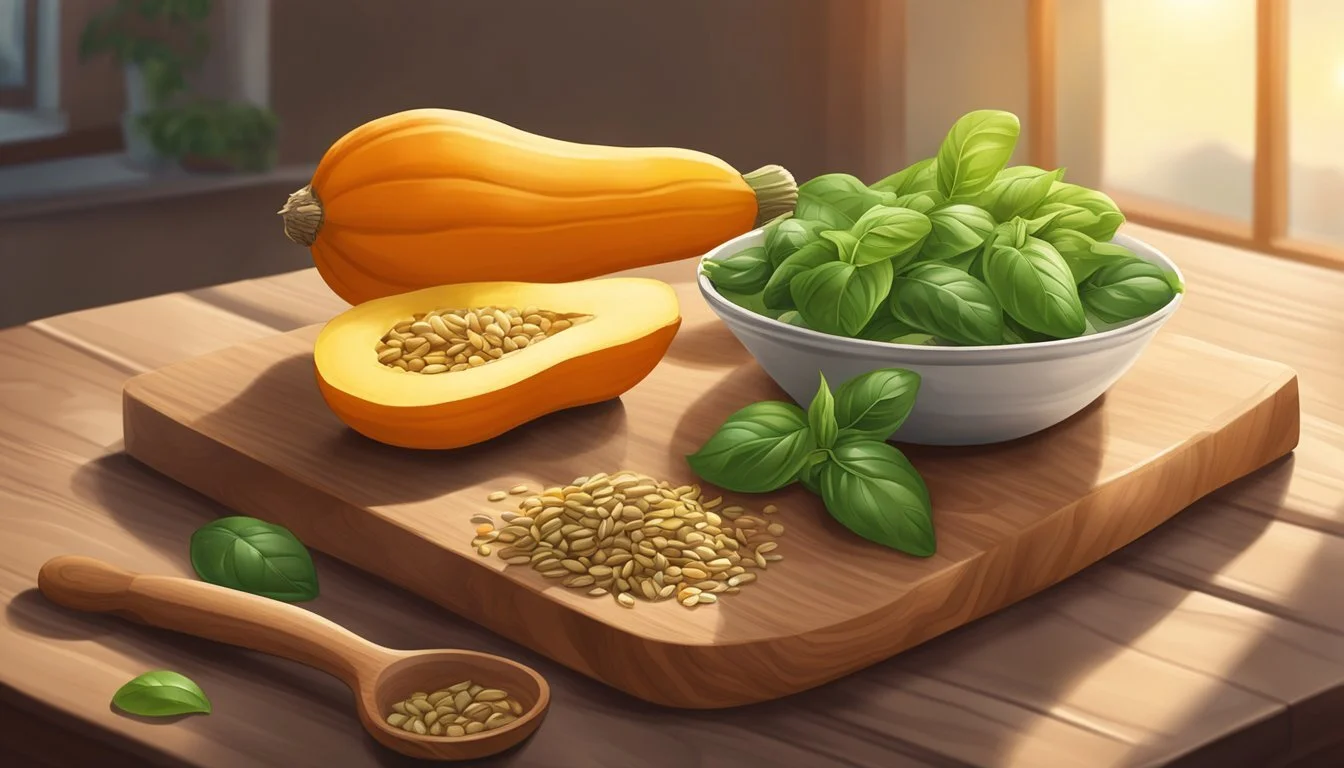Squash Seed Pesto
A Nutty, Autumnal Spread Perfect for Seasonal Delight
Autumn ushers in a bountiful harvest, and with it comes the versatile squash, playing a starring role in seasonal dishes. One innovative way to use the entirety of this bountiful gourd is to create a nutty and flavorful squash seed pesto. This spread is a testament to the creativity of modern cuisine, transforming what would otherwise be compost or discarded seeds into a delicious and nutritious condiment. Roasting the seeds brings out a rich, nutty flavor that pairs beautifully with traditional pesto herbs, such as basil, parsley, and sage, adding a unique twist to the classic recipe.
Squash seed pesto can serve as more than just a pasta enhancer; it's a multi-purpose spread that can elevate a variety of dishes. Whether it's spread over freshly baked bread, drizzled over roasted vegetables, (What wine goes well with roasted vegetables?) or used as a dip, this autumnal creation encapsulates the essence of the season. The textural contrast of the crunchy seeds ground into a smooth paste also adds an element of surprise to the palate. As a bonus, utilizing the seeds aligns with a more sustainable approach to cooking, ensuring that every part of the harvest is utilized to its fullest potential.
The Nutritional Profile of Squash Seed Pesto
Squash seed pesto emerges as a healthful option that integrates the nutritional potency of squash seeds into a flavorsome spread. Squash seeds are particularly praised for their magnesium content—a mineral essential for numerous bodily functions, including muscle and nerve function.
Nutritional Elements:
Fiber: The spread is inherently high in dietary fiber, promoting digestive health and aiding in satiety.
Protein: Squash seeds contribute plant-based protein, which is crucial for muscle repair and overall cellular health.
Healthy Fats: They possess unsaturated fats, which are beneficial for heart health.
Calories: When considering calorie content, squash seed pesto is relatively calorie-dense due to the oil and seeds, yet it offers a nutrient-rich profile. Moderation is key to maintaining a balanced diet.
The following table breaks down the primary nutritional components found in a typical serving of squash seed pesto:
Nutrient Amount per serving Calories Variable Protein Moderate Fiber High Healthy Fats High Magnesium High
With the nutritional value of squash seed pesto in focus, it's apparent that incorporating this spread into one's diet can contribute to a well-rounded intake of essential nutrients. It is a particularly adept choice for those seeking to increase their intake of fiber, protein, and magnesium—all packed in a versatile and palatable form. Consider portion sizes to align consumption with individual dietary needs and goals.
Essential Ingredients for Squash Seed Pesto
Creating a rich and nutty squash seed pesto requires a balance of ingredients that contribute to its unique flavor profile. The following are key components one should consider when crafting this autumnal spread.
Choosing the Right Squash
Selecting the right type of squash is fundamental for the pesto's flavor and texture. Butternut squash and spaghetti squash are popular options due to their slightly sweet taste and creamy consistency when roasted. For the best results, one should roast the butternut squash until it is lightly browned and caramelized, helping to unlock its natural sweetness.
Pumpkin Seeds and Alternatives
Pumpkin seeds, or pepitas, are the traditional choice for squash seed pesto. They should be toasted to enhance their nutty flavor before blending. Alternatives like toasted pine nuts or walnuts can be used to achieve a similar texture and taste.
Seed or Nut Options Notes on Usage Pumpkin Seeds Toast before using to intensify flavor. Pine Nuts Toast lightly for a creamy consistency. Walnuts A good choice for their rich and earthy notes.
Oils and Cheeses for Richness
A quality olive oil adds smoothness and ties the flavors together. For cheese, Parmesan is a classic choice, providing a salty and savory note. Vegans may substitute Parmesan with nutritional yeast or a vegan cheese alternative. Ricotta can be incorporated to add creaminess.
Oil and Cheese Options Vegan Alternatives Olive Oil Essential for consistency Parmesan Cheese Use nutritional yeast or vegan cheese Ricotta Optional for creamy texture
Herbs and Seasonings
Fresh herbs like sage and parsley infuse the pesto with a floral and earthy character. Garlic provides a pungent kick, essential to classic pesto. When seasoning, a combination of kosher salt and black pepper is recommended to enhance the pesto's overall flavor profile.
Seasoning Purpose Sage and Parsley Add depth with their fresh, aromatic qualities Garlic Delivers a sharp, unmistakable flavor Salt and Black Pepper Use kosher salt and freshly ground black pepper to season
Step-by-Step Cooking Instructions
This section provides a detailed guide to making Squash Seed Pesto. The reader will learn how to properly prepare the ingredients, efficiently blend the pesto to achieve a creamy consistency, and adjust the flavoring and texture to taste.
Preparing Your Ingredients
Squash Seeds: Begin by gathering the seeds from the squash. Typically, one squash yields enough seeds for a batch of pesto. Toast them on a baking sheet in a preheated oven at 375°F for about 5 minutes or until they turn a golden-brown color. Ensure they are evenly spread on the sheet to avoid burning.
Broccoli: If incorporating broccoli, blanch the florets briefly, then immerse in cold water to stop the cooking process, and pat them dry.
Garlic: Peel and roughly chop the garlic cloves to ensure they blend easily.
Cheese: For richness, grate the Parmesan cheese. For a vegan option, one may omit this or use a plant-based substitute.
Lemon Juice: Fresh lemon juice works best to lend the pesto a bright, zesty flavor.
Olive Oil: This will be used both in the pesto and for roasting additional ingredients like the squash itself.
Seasonings: Salt and freshly ground black pepper are indispensable for seasoning both the seeds prior to roasting and the final pesto.
Blending Your Pesto
Place the roasted squash seeds, blanched broccoli, chopped garlic, Parmesan cheese, and a pinch of sea salt into a food processor. Begin to blend the ingredients while slowly adding in olive oil until the mixture becomes creamy and cohesive. Halfway through, squeeze in the fresh lemon juice, which will brighten up the flavors and add a subtle tang.
Adjusting the Texture and Flavor
The desired texture for pesto is generally smooth with a bit of texture from the squash seeds. If the mixture is too thick, one can drizzle in additional olive oil while blending until the right consistency is achieved. For additional flavor adjustments:
Salt: Add to taste, being cautious not to over-salt.
Pepper: A generous grind of black pepper can complement the nuttiness of the squash seeds.
Lemon Juice: If the pesto needs more acid, add a bit more fresh lemon juice.
Taste and modify the pesto as desired. The final result should be a nutty, autumnal spread that complements the roasted squash or other dishes well.
Serving Suggestions for Squash Seed Pesto
Squash seed pesto serves as a robust and nutty spread that can transform everyday dishes. Its versatility allows it to complement various meals, offering a flavorful twist to classic recipes.
Pasta Pairings
Pesto Spaghetti Squash: A light yet satisfying alternative to traditional pasta, spaghetti squash can be roasted and then fluffed into strands to mimic noodles. Tossed with squash seed pesto, it becomes a heart-healthy dish, perfect for autumn evenings.
Spaghetti Squash Pad Thai: For an autumnal spin on a classic, mix squash seed pesto with tamarind and lime juice, then combine with spaghetti squash strands for a nutty pad Thai variation.
Healthy Salads and Sides
Arugula, Kale, and Spinach Salads: These greens create a perfect base for the rich flavor of squash seed pesto. Use it as a dressing or a garnish to add depth to any salad.
Side Dish: Squash slices roasted until tender, then topped with a dollop of pesto, create a simple and flavorful side that pairs well with any main course.
Innovative Uses for Pesto
Soup Garnish: Swirl a spoonful of squash seed pesto into soups for a nutty punch.
Sandwiches: Spread on bread for an autumn-inspired sandwich, adding a new layer of flavor to the usual lunch (What wine goes well with lunch?) fare.
Dip or Trail Mix: Use as a dip for crudités or crackers, or stir into a trail mix for a savory snack option.
Customizing Your Pesto for Dietary Needs
Adapting squash seed pesto to meet various dietary requirements is straightforward. The recipe is inherently health-focused, emphasizing nutrition without compromising on flavor. Below are ways to modify the pesto recipe for those following vegan, gluten-free, and keto diets, ensuring everyone can enjoy this autumnal spread.
Vegan Modifications
For a vegan-friendly version of squash seed pesto, traditional ingredients like Parmesan cheese can be replaced with nutritional yeast to maintain the cheesy flavor. Here's a simple swap:
Parmesan Cheese: Substitute with equal parts nutritional yeast for a non-dairy cheesy flavor.
Gluten-Free Options
Squash seed pesto is naturally gluten-free, but one must be cautious with additional ingredients or when serving with other foods. Adopt these practices for a safe gluten-free option:
Always check the labels on processed ingredients to ensure they are certified gluten-free.
Serve with gluten-free pasta or veggie sticks rather than traditional bread or crackers.
Keto-Friendly Ingredients
To transform squash seed pesto into a keto-compatible condiment, make sure to limit any ingredients high in carbohydrates. Here's how to keep it keto:
Squash Seeds: Use these seeds as they are low in net carbs and high in healthy fats, ideal for keto.
Oil: Opt for an oil that is rich in monounsaturated fats, like extra virgin olive oil, to enhance the keto factor.
Supplementary Information
Perfected through experimentation, squash seed pesto emerges as a distinctive spread, ideal for those seeking to enhance their dining experience with a nutty and herby autumnal touch. This supplementary information offers insights on its storage, food pairings, and tips to ensure the pesto's texture and flavor meet the highest standards.
Storage and Shelf Life
Storage: Homemade squash seed pesto should be stored in an airtight container in the refrigerator.
Shelf Life: It can typically last for up to one week.
Food Pairings and Combinations
Veggies: Squash seed pesto pairs well with roasted vegetables such as sweet potatoes, onions, and broccoli.
Lunch and Thanksgiving: It serves as a flavorful addition to lunch sandwiches and is an excellent condiment for Thanksgiving dinners.
Creamy Pasta: When combined with white beans, it can create a creamy pasta sauce.
Tips for Perfect Texture and Flavor
Texture: For a smoother consistency, blend the pesto thoroughly; for a chunkier texture, pulse briefly.
Flavor Notes:
Add grated parmesan cheese for a salty, umami kick.
Incorporate sage for an aromatic layer.
For a richer taste, toast the pumpkin seeds before blending.
Unique Variations of Squash Seed Pesto
Squash seed pesto offers a twist on the traditional pesto with the inclusion of seeds from various types of squash, like pumpkin seeds, also known as pepitas. They add a distinctive nutty flavor and are rich in nutrients.
Spinach-Squash Seed Pesto: This version replaces traditional basil with spinach, giving the pesto a milder taste. Spinach also boosts the nutritional value, making it a hearty choice for health-conscious individuals.
Ingredients:
Spinach
Roasted squash seeds
Garlic
Parmesan cheese
Olive oil
Lemon juice
Salt and pepper
Sage and Pumpkin Seed Pesto: The addition of sage to pumpkin seed pesto creates a variant that has a deep, autumnal aroma. It pairs well with heartier dishes. Lemon juice can be added to enhance its flavor profile, brightening the pesto and adding a subtle zing.
Suggested Pairings:
Hearty breads
Marinara sauce bases
Cranberry and Pepita Pesto: For a touch of sweetness and a pop of color, dried cranberries can be mixed into pepita pesto. This version is especially fitting for festive occasions.
Ingredients:
Pumpkin seeds
Dried cranberries
Fresh parsley
Garlic
Olive oil
Cumin-Infused Pesto: Incorporating ground cumin into squash seed pesto lends an earthy spice, creating a fusion pesto that is both aromatic and flavorful.
Pair with:
Grilled vegetables (What wine goes well with grilled vegetables?)
Flatbreads
These unique variations on squash seed pesto show the versatile nature of this spread, allowing it to be adapted for a variety of tastes and dietary preferences. Each ingredient picked for the variations contributes to a flavorful, nutritious, and adaptable option for pesto lovers everywhere.
Connect With Us
This section invites readers to become a part of the culinary conversation surrounding Squash Seed Pesto and to enrich the community with their personal cooking experiences.
Share Your Creations
They encourage individuals to show off their culinary skills by sharing photos and stories of their own Squash Seed Pesto creations. By tagging them in social media posts or using their designated hashtag, home cooks can connect with others who share their passion for autumnal flavors.
Instagram: Share your dish with the hashtag
#SquashSeedPestoLoveFacebook: Tag them in your post showing your pesto-plated dishes
Sign Up for More Recipes
They offer a newsletter filled with inspiring recipes, including innovative ways to use Squash Seed Pesto. By providing an email, food enthusiasts can stay updated with the latest seasonal spreads and receive exclusive content directly to their inbox.
Email Subscription: To subscribe, send an email to recipes@autumnalspreads.com with the subject line "Subscribe".
Recipe Alerts: Subscribers will receive weekly emails with hand-picked recipes and tips.
Final Thoughts
Squash seed pesto is a celebration of autumn's bounty, offering a twist on traditional pesto with its nutty and savory tones. Utilizing seeds such as pumpkin or butternut squash seeds—pepitas—elevates the dish with a crunchy texture and a hint of earthiness.
One can appreciate the versatility of squash seed pesto; it pairs well with various dishes from roasted vegetables to pasta. Chefs and home cooks alike are finding that the inclusion of sage, garlic, and miso paste brings depth and complexity to the flavor profile, making every bite a truly unique experience.
Incorporating lemon juice not only adds a touch of acidity but also brightens the overall taste. This adjustment ensures that the pesto maintains a palate-cleansing freshness amidst its richer ingredients.
Health-conscious individuals will find reassurance in the pesto’s nutritional profile, as squash seeds are a source of antioxidants and essential minerals like magnesium and zinc. Olive oil, a staple in pesto, contributes heart-healthy fats, reinforcing the spread's place in a balanced diet.
Crafting this pesto is a simple process, one that encourages experimentation with proportions and additional ingredients, inviting chefs to refine the recipe to their taste. And as it can be easily preserved, squash seed pesto can be enjoyed long after the autumn leaves have fallen.

